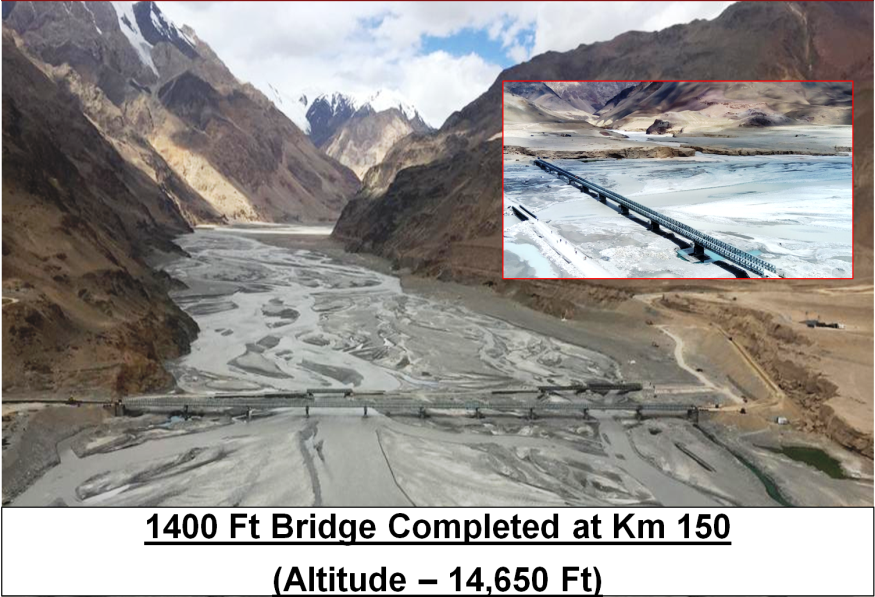
Since DBO/Galwan/Depsang areasre in the news, it is important to put the area in context. (see map) Darbuk-Shyok-Daulat Beg Oldi (DBO) Road in Ladakh which provides access to Depsang plain and Galwan Valley was completed by the Border Roads Organisation (BRO) exactly a year ago. 

It has taken almost 15 years for the road to be operational. Shyok is the last inhabited village. DBO, the terminal point of the road is at an altitude of 16750 ft, not very far from Karakoram Pass which is with China. The minimum temperature reaches upto minus 55 degrees C here.
The alignment of DS-DBO 255 Km road mostly runs along the banks of Tangtse and Shyok rivers. Numerous glaciers and glaciated lakes on the Great Eastern Karakoram Range exist above the road alignment.
Waters form melting/ breaking of these glaciers drain into the valley triggering avalanches and landslides. This gives rise to formation of Glaciated Lake Outburst Floods (GLOF). Cloud bursts and change of river flow directions are common.
Construction of the road in these conditions is not easy. The road has numerous rivers and nallahs. 37 bridges had to be launched to establish connectivity. One of the bridges on Shyok river has a span of 1400 ft. Micro Piling technology was adopted for foundations of this bridge 

It was constructed in a record time of 14 months. More than 1800 troops and 3500 labourers were involved in the construction of this road. It must be remembered that induction of manpower at these altitudes requires third stage acclimatization. It means 21 days of acclamitisation
The schedule of acclamitisation is: approx 7 days at 9,000 feet; 7 days at 12000 ft and 7 days at 14000 ft. There is no compromise on this schedule. The work continues in winter with continuous snow clearance operations and personnel remaining on duty throughout the year.
Soil stabilisation methodology has been successfully adopted for speedy construction of this road. The road is now fully connected upto DBO and 201 Km length has been surfaced. The remaining surfacing will be completed by 2020.
Why am I telling you all this? To set the context of the Chinese aggressiveness in the area. India's improved connectivity (DBO airstrip is capable of accepting landing by the C-130J medium airlift aircraft of the IAF) means that the Chinese no longer have a free run in the area
So if you hear of increasing standoffs happening across the LAC, it is because India's infrastructure work in border areas has picked up pace in recent years. And so has its troops deployment (a separate thread soon on that)
BRO is constructing 61 India-China Border Roads (ICBRs) with total length of 3346 Km (across the Himalayan frontier). Out of these, 75% road length is black top and over 99% is trafficable. Only 40 Km is yet to be connected.
In Apr 2018, only 28 roads were completed. Due to recent concerted efforts, five roads were completed in 2019 and 11 are being completed this year. Another nine roads will be completed in 2021 while six more roads will be completed by Mar 2022.
The overall BRO Budget between 2009 to 2014-15 generally remained stagnant at around Rs 4000 Cr. It has increased in last couple of years.: ₹ 5400 Cr in 2018; ₹8000 Cr in 2019-20; it is likely to cross ₹10000 Cr in 2020-21.The infusion of Capital Fund has also increased.
Dual purpose roads, primarily meant for movement of public, worth ₹ 2000 Cr are being funded by other agencies. The Central Road Infrastructure Fund (CRIF) has given a budgetary support of ₹ 2300 Cr. It is evident that there has been an exponential increase in the outcomes
The BRO continues to work in harsh terrain and adverse weather conditions with great dedication, contributing in infrastructure work, living up to its reputation by meeting the aspirations of the Armed Forces, State Govts, GoI and the people living in border areas. ENDS
• • •
Missing some Tweet in this thread? You can try to
force a refresh








